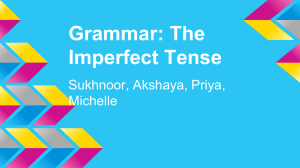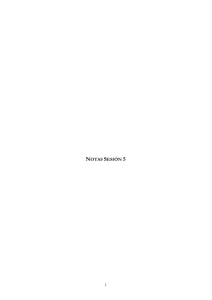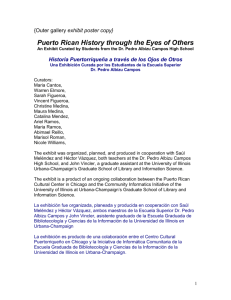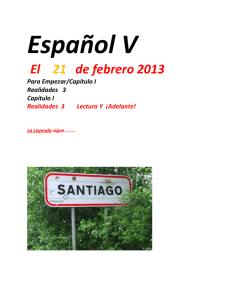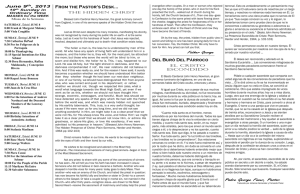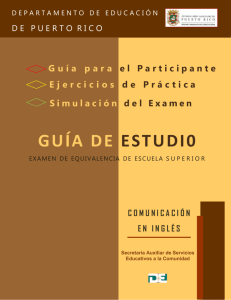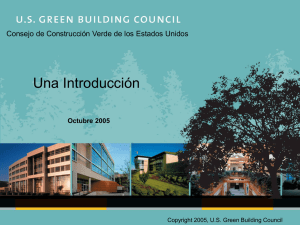2015-Estambul - De Artes y Pasiones
advertisement
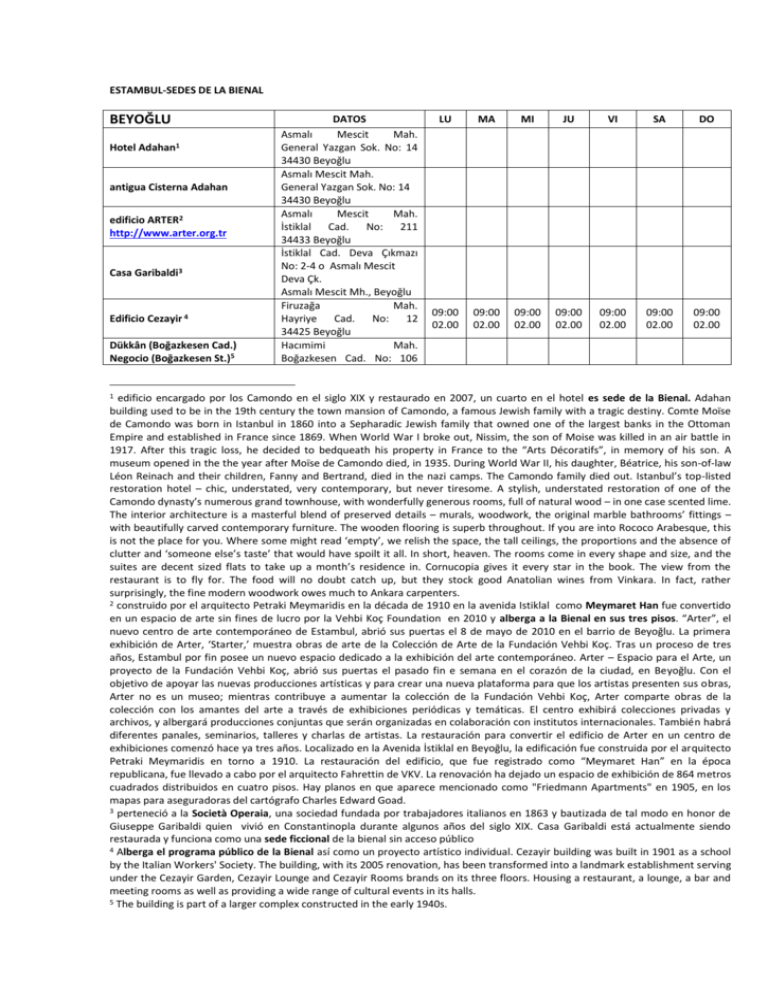
ESTAMBUL-SEDES DE LA BIENAL BEYOĞLU Hotel Adahan1 antigua Cisterna Adahan edificio ARTER2 http://www.arter.org.tr Casa Garibaldi3 Edificio Cezayir 4 Dükkân (Boğazkesen Cad.) Negocio (Boğazkesen St.)5 1 DATOS Asmalı Mescit Mah. General Yazgan Sok. No: 14 34430 Beyoğlu Asmalı Mescit Mah. General Yazgan Sok. No: 14 34430 Beyoğlu Asmalı Mescit Mah. İstiklal Cad. No: 211 34433 Beyoğlu İstiklal Cad. Deva Çıkmazı No: 2-4 o Asmalı Mescit Deva Çk. Asmalı Mescit Mh., Beyoğlu Firuzağa Mah. Hayriye Cad. No: 12 34425 Beyoğlu Hacımimi Mah. Boğazkesen Cad. No: 106 LU MA MI JU VI SA DO 09:00 02.00 09:00 02.00 09:00 02.00 09:00 02.00 09:00 02.00 09:00 02.00 09:00 02.00 edificio encargado por los Camondo en el siglo XIX y restaurado en 2007, un cuarto en el hotel es sede de la Bienal. Adahan building used to be in the 19th century the town mansion of Camondo, a famous Jewish family with a tragic destiny. Comte Moïse de Camondo was born in Istanbul in 1860 into a Sepharadic Jewish family that owned one of the largest banks in the Ottoman Empire and established in France since 1869. When World War I broke out, Nissim, the son of Moise was killed in an air battle in 1917. After this tragic loss, he decided to bedqueath his property in France to the “Arts Décoratifs”, in memory of his son. A museum opened in the the year after Moïse de Camondo died, in 1935. During World War II, his daughter, Béatrice, his son-of-law Léon Reinach and their children, Fanny and Bertrand, died in the nazi camps. The Camondo family died out. Istanbul’s top-listed restoration hotel – chic, understated, very contemporary, but never tiresome. A stylish, understated restoration of one of the Camondo dynasty’s numerous grand townhouse, with wonderfully generous rooms, full of natural wood – in one case scented lime. The interior architecture is a masterful blend of preserved details – murals, woodwork, the original marble bathrooms’ fittings – with beautifully carved contemporary furniture. The wooden flooring is superb throughout. If you are into Rococo Arabesque, this is not the place for you. Where some might read ‘empty’, we relish the space, the tall ceilings, the proportions and the absence of clutter and ‘someone else’s taste’ that would have spoilt it all. In short, heaven. The rooms come in every shape and size, and the suites are decent sized flats to take up a month’s residence in. Cornucopia gives it every star in the book. The view from the restaurant is to fly for. The food will no doubt catch up, but they stock good Anatolian wines from Vinkara. In fact, rather surprisingly, the fine modern woodwork owes much to Ankara carpenters. 2 construido por el arquitecto Petraki Meymaridis en la década de 1910 en la avenida Istiklal como Meymaret Han fue convertido en un espacio de arte sin fines de lucro por la Vehbi Koç Foundation en 2010 y alberga a la Bienal en sus tres pisos. “Arter”, el nuevo centro de arte contemporáneo de Estambul, abrió sus puertas el 8 de mayo de 2010 en el barrio de Beyoğlu. La primera exhibición de Arter, ‘Starter,’ muestra obras de arte de la Colección de Arte de la Fundación Vehbi Koç. Tras un proceso de tres años, Estambul por fin posee un nuevo espacio dedicado a la exhibición del arte contemporáneo. Arter – Espacio para el Arte, un proyecto de la Fundación Vehbi Koç, abrió sus puertas el pasado fin e semana en el corazón de la ciudad, en Beyoğlu. Con el objetivo de apoyar las nuevas producciones artísticas y para crear una nueva plataforma para que los artistas presenten sus obras, Arter no es un museo; mientras contribuye a aumentar la colección de la Fundación Vehbi Koç, Arter comparte obras de la colección con los amantes del arte a través de exhibiciones periódicas y temáticas. El centro exhibirá colecciones privadas y archivos, y albergará producciones conjuntas que serán organizadas en colaboración con institutos internacionales. También habrá diferentes panales, seminarios, talleres y charlas de artistas. La restauración para convertir el edificio de Arter en un centro de exhibiciones comenzó hace ya tres años. Localizado en la Avenida İstiklal en Beyoğlu, la edificación fue construida por el arquitecto Petraki Meymaridis en torno a 1910. La restauración del edificio, que fue registrado como “Meymaret Han” en la época republicana, fue llevado a cabo por el arquitecto Fahrettin de VKV. La renovación ha dejado un espacio de exhibición de 864 metros cuadrados distribuidos en cuatro pisos. Hay planos en que aparece mencionado como "Friedmann Apartments" en 1905, en los mapas para aseguradoras del cartógrafo Charles Edward Goad. 3 perteneció a la Società Operaia, una sociedad fundada por trabajadores italianos en 1863 y bautizada de tal modo en honor de Giuseppe Garibaldi quien vivió en Constantinopla durante algunos años del siglo XIX. Casa Garibaldi está actualmente siendo restaurada y funciona como una sede ficcional de la bienal sin acceso público 4 Alberga el programa público de la Bienal así como un proyecto artístico individual. Cezayir building was built in 1901 as a school by the Italian Workers' Society. The building, with its 2005 renovation, has been transformed into a landmark establishment serving under the Cezayir Garden, Cezayir Lounge and Cezayir Rooms brands on its three floors. Housing a restaurant, a lounge, a bar and meeting rooms as well as providing a wide range of cultural events in its halls. 5 The building is part of a larger complex constructed in the early 1940s. Ev (Bostanbaşı Sok.) Casa (Bostanbaşı St.)6 FLO Binası (Anadolu Pasajı) FLO Building (Anatolian Passage)7 Fransız Yetimhanesi French Orphanage8 Galata Özel Rum İlköğretim Okulu Galata Greek Primary School9 The House Hotel Galatasaray10 Istanbul Modern11 6 34425 Beyoğlu Firuzağa Mah. Bostanbaşı Sok. No: 30 34425 Beyoğlu Kuloğlu Mah. Istiklal Cad. Anadolu Han D: 201. 34433 Beyoğlu Official access denied due to unresolved international historic competing claims. Bogazkesen Caddesi No 161, Tophane, Beyoglu Hacımimi Mah. Kemeraltı Cad. No: 49 34425 Beyoğlu Hacımimi Mah. Bostanbaşı Cad. No: 19 34425 Beyoğlu Meclis-i Mebusan Cad. NO 10:00 10:00 10:00 10:00 10:00 10:00 A former private home across from The House Hotel Galatasaray at Bostanbaşı Street No. 30. Located on İstiklal Avenue, this building, originally named the Anatolian Passage, was built in the early 20th century for Ragıp Paşa and now functions as a shoe store. Uno de los Pasajes turcos construido a finales del siglo XIX y actualmente una zapatería, es transformada en sede para un trabajo artístico en su cuarto piso 8 The Palace of St. Eugène was built as an orphanage in 1868, and it became the atelier of an Armenian plaster caster Garabet Cezayirliyan in the mid-twentieth century. The property is contested and it is currently home to a workshop and archive of Art Nouveau moulds. Es una de las tres sedes ficcionales de la Bienal, que no tienen acceso público permitido sino solamente imaginario. Participa en el evento con la colaboración de AC/E el español Fernando García- Dory, que lleva a cabo el proyecto The Water Course. Un proyecto educacional llevado a cabo por los principales actores de realidad actual en Turquía. Una dinámica de aprendizaje que pone en contacto a diferentes organizaciones y movimientos sociales en Estambul y otras partes del mundo. El proyecto se desarrolla en diferentes localizaciones de la ciudad con base en el St. Eugene Palace, al que se quiere salvar de la especulación y privatización dotándole de contenido educacional y cultural público. 9 The Galata Greek Primary School on Kemeraltı Street near the Bosphorus was built between 1885 and 1909 in a Neo-classical architectural style for the education of Greek children in Istanbul. Due to the decrease of the Greek population, especially from the 1960s onwards, the school closed in 1988 and then again in 2007. Galata Greek Primary School with its neo-classic architectural style was constructed in the late nineteenth century for the education of Greek children in Istanbul. The school had to suspend its activities in September 1988, due to the demographic changes that arose in Istanbul during the 60s and 70s. In 2001, it started operating as a nursery school in order to increase the student capacity and improve the quality of education, but was eventually forced to close again in 2007, due to lack of students. In 2012, the Galata Greek Primary School opened its doors to one of the two main exhibitions of the Istanbul Design Biennial, “Adhocracy”, curated by Joseph Grima. 10 En las cercanías de Galatasaray, en un cuarto de hotel del edificio originalmente encargado y construido por la familia Zenovitch en la década de 1890, que fue transformado en el en 2010, es usado como sede de la Bienal. Originally commissioned by the Zenovitch family, this 1880 building was designed by a Serbian architect and transformed into a hotel in April 2010. The building reflects the floral stone masonry developed in Istanbul after the great fire of 1870, which destroyed many wooden buildings in the area. Room 2 is a biennial venue. Located in the artistic enclave of Çukurcuma famed for its galleries and boutiques, the House Hotel Galatasaray is the ideal location to explore Beyoğlu's culture. Housed in the historic 1890s Zenovitch Apartment, the hotel opened in April 2010. Renovated by our signature Turkish design collaborator - international award-winning Autoban Design firm the building retains its original shuttered façade, marble staircase and ceramic tiled reception. The lounge bar on the top floor offers outstanding views over Istanbul's red roofs and the Galata Tower. Just down the hill from Istiklal Avenue, the hotel is a convenient base to discover the city on foot or using the nearby tram, ferry and subway connections. 11 Built by the architect Sedad Hakkı Eldem in the scope of an urban revitalisation project between 1957 and 1958, Antrepo No. 4 is a former cargo warehouse on the Bosphorus. It was designed as a part of a larger Galata pier complex by the Turkish Maritime Organisation. In 2003, the 8,000 square-meter warehouse was transformed into a contemporary museum building and opened to the public in 2004. The pier continues to serve as Istanbul's main port. The façade facing the Bosphorus as well as the ground floor are venues. ARTISTS IN THEIR TIME. Istanbul Modern’s collection exhibition, “Artists in Their Time”, focuses on how artists position their work and themselves within the concept of time. It suggests a conceptual field for examining, and reconciling, the links between an artist’s time and societal, cultural, natural and universal time. It unites artists from very different periods, geographies and disciplines around common themes. “Artists in Their Time” highlights how artists experience their own times, feel anxious and frustrated that time emerges from the past and flows into the future, and form bonds between their own internal time and that of others. The exhibition also presents a base for discussing the place of art in transience and change and the transformation of art. Through which times does a work of art pass to become part of the present, of the moment we are now observing? What is the meaning of the temporal relationship that works of art establish with one another? What conditions do works of art resist, or what 7 Admission Fee Regular: 19 TL Discounted (Students, 65 and older): 9 TL Film Screenings Istanbul Modern Cinema: 9 TL Kasa Galeri12 Liman İşletmeleri Sahası 34433 Tophane Karaköy, Meclis-i Mebusan Cad., 34433 Beyoğlu Tel.: +90 212 334 7300 http://www.istanbulmodern .org/en Bereketzade Mah. 18:00 18:00 20:00 18:00 18:00 18:00 10:00 conditions are they absorbed into, in order to maintain their relevance in the future? “Artists in Their Time” takes as its starting point the words of Ahmet Hamdi Tanpınar (1901-1962), one of Turkey’s foremost intellectual and literary figures: “I am neither within time nor completely outside of it.” Tanpınar’s views about time illuminate the process by which artists come to terms with the relationship of their work with the past, the present and the future. Accordingly, this exhibition groups together works of art from distinct geographies, periods and disciplines that share the same emotions with respect to a variety of themes: the intersecting responses of abstract art from different periods; the role of materials and studios in the production of art; the transformation from landscapes and still lifes to the present conception of nature; the search for identity; attraction to the Higher and the spiritual; existential questioning; body politics; feminist approaches; the complex problems imposed by the new urban culture; the struggle against war, death and destruction; life stories from Istanbul, a metropolis defined by water and embracing the sea; and efforts to understand the people of Anatolia. “Artists in Their Time” offers a roadmap for understanding artists’ intertemporal, existential journey through time as conceptualized in Tanpınar’s work. In an age when we are able to imagine a variety of times simultaneously, the exhibition also reminds us of the comprehensive breadth of Tanpınar’s views. Artists: Fahrelnissa Zeid, Aliye Berger, Semiha Berksoy, Bedri Rahmi Eyüboğlu, Cihat Burak, Adnan Varınca, Avni Arbaş, Cafer Türkmen, Naile Akıncı, Aziz Albek, Nejad Melih Devrim, Neşet Günal, Gökşin Sipahioğlu, Adnan Çoker, Turan Erol, Ara Güler, Albert Bitran, Burhan Doğançay, Ömer Uluç, Erol Akyavaş, Yıldız Moran, Yüksel Arslan, Atilla Torunoğlu, Tülay Tura Börtecene, Devrim Erbil, Georg Baselitz, Mehmet Güleryüz, Hermann Nitsch, Sarkis, Nil Yalter, Neş’e Erdok, Burhan Uygur, Nur Koçak, Komet, Seyhun Topuz, Koray Ariş, Anselm Kiefer, Gülsün Karamustafa, Balkan Naci İslimyeli, Richard Wentworth, Tony Cragg, Richard Deacon, Azade Köker, Fatma Tülin, Şahin Kaygun, Erdağ Aksel, Kemal Önsoy, Barbara & Zafer Baran, William Kentridge, Canan Tolon, Coşkun Aral, İnci Eviner, Hüseyin Bahri Alptekin, Bedri Baykam, Handan Börüteçene, Tayfun Erdoğmuş, Julian Opie, İrfan Önürmen, Jennifer Steinkamp, Nuri Bilge Ceylan, Canan Dağdelen, Selma Gürbüz, Hale Tenger, Kutluğ Ataman, Mark Bradford, Aydan Murtezaoğlu, Manuel Çıtak, Gül Ilgaz, Merih Akoğul, Michael Raedecker, Pae White, Liam Gillick, Ekrem Yalçındağ, Vahap Avşar, Murat Germen, Mustafa Horasan, Ferhat Özgür, Ramazan Bayrakoğlu, Monica Bonvicini, Taner Ceylan, Olafur Eliasson, Doug Aitken, Ergin Çavuşoğlu, Margherita Manzelli, Gülay Semercioğlu, Murat Akagündüz, Haluk Akakçe, Hüseyin Çağlayan, Jennifer Allora & Guillermo Calzadilla, Ali Kazma, Servet Koçyiğit, Nuri Kuzucan, Şener Özmen, Vahit Tuna, Sterling Ruby, Tomas Saraceno, Fikret Atay, Cevdet Erek, Ebru Uygun, Elliott Hundley, Matt Saunders, Nilbar Güreş, Seçkin Pirim, Ali Alışır, Murat Pulat, Ardan Özmenoğlu, Burcu Perçin, Burcu Yağcıoğlu, :mentalKLINIK. June 10 – November 15, 2015 YAP ISTANBUL MODERN: YOUNG ARCHITECTS PROGRAM: Initiated by Istanbul Modern in collaboration with The Museum of Modern Art (MoMA) and MoMA PS1 in 2012, the YAP Istanbul Modern: Young Architects Program is held biannually during the summer and offers young, emerging architects the opportunity to design a temporary installation in Istanbul Modern’s courtyard. The program’s aim is to encourage architects to address environmental issues such as sustainability, re-use, and re-cycling, and to explore innovative design ideas providing elements of shade, water, and seating that would increase the possibilities of use in open-air spaces. Providing a popular urban venue for the summer, these designs are expected to protect visitors from the heat of the city, host diverse events, and create intimate social spaces for city-dwellers―all within a modest budget and through reasonable architectural solutions. The YAP: Young Architects Program began in 1998 in MoMA PS1’s courtyard in New York and became international with the participation of CONSTRUCTO in Santiago, Chile, the National Museum of XXI Century Arts (MAXXI) in Rome, Italy, the National Museum of Modern and Contemporary Art in Seoul, South Korea alongside Istanbul Modern. The jury, which came together to select the winning project, was formed of architectural experts and of representatives from Istanbul Modern and the other YAP: Young Architects Programs. From among the proposals of the five finalists the jury selected the project “ALL THAT IS SOLID” designed by PATTU. “ALL THAT IS SOLID” is a temporary site-specific installation that is inspired by the industrial history of the area, it is a reminder of the past but also a statement about the imminent change the future holds, so we can be more critical about it. Program Coordinators & Finalists Exhibition Curators: Çelenk Bafra, Pelin Derviş 12 Minerva Han is a landmark historical building that was constructed as the Bank of Athens in 1913 by architect Vasileios Kouremenos in an Art Nouveau style. It was later acquired by Deutsche Bank in the 1930s and more recently has become a part of Sabancı University. The former bank vault in the building was converted to an exhibition space called ‘Kasa Galeri'. Kasa Galeri is located in the basement vault of the Minerva Han, a splendid Islamic Revival–style building that was built as the Greek-owned Bank of Athens in the early 20th century. Funded by Sabaci University, it supports and exhibits collaborative international art projects that are experimental in nature. It also offers residencies and shows to emerging Turkish artists. On the corner of Bankalar Caddesi and Yüksek Kaldırım, overlooking the square in Karaköy: 2 mins from the Karaköy tram stop and lower Tünel station; 5 mins from the boat stations serving Kadıköy and the Üsküdar–Golden Horn boat. The Sabancı University’s downtown arts and culture centre approaches the fine arts in an ‘experimental, internationally minded, collaborative and research-based way’. The gallery occupies the vaults (kasa = safe) of the landmark Minerva Han (built in the early 20th century for the Bank of Athens), at the heart of the old Masumiyet Müzesi The Museum of Innocence13 Otopark (Boğazkesen Cad.) Garage (Boğazkesen St.)14 Otopark (Çukurcuma Cad.) Garage (Çukurcuma St.)15 Özel İtalyan Lisesi The Italian High School16 Pera Müzesi Pera Museum17 Bankalar Cad. No: 2 Minerva Han 34420 Beyoğlu Çukurcuma Cad. Dalgıç Çıkmazı No: 2 Beyoğlu www.masumiyetmuzesi.org Hacımimi Mah. Boğazkesen Cad. No: 108/A 34425 Beyoğlu Çukurcuma Cad. No: 7 Hacımimi Mah. 34425 Beyoğlu Tomtom Mah. Tomtom Kaptan Sok. No: 3 34433 Beyoğlu Tel. +90 212 2441301 – +90 212 2524584 Asmalı Mescit Mah. Meşrutiyet Cad. No: 65 17:00 Ottoman financial district of Karaköy. Sabancı University also own the Sakıp Sabancı Museum in Emirgan. The gallery was founded in 1999 and until 2010, it was curated by Erdag Aksel and Selim Birsel, whose noteworthy exhibitions included Yoko Ono and Hermann Nitsch. Since 2011 it has been under the curatorial guidance of Lanfranco Aceti. The gallery hosts month-long exhibitions 10–12 times per year and has engaged in collaborations – for exhibitions and publications – with important international partners such as Goldsmiths, FACT, Waterman’s, Zero1 Biennial and MIT Press. In accordance with its mission to promote young artists, Kasa has been running an annual residency programme for young Turkish artists since 2012. It also participated in the 12th Istanbul Biennial 13 The Brukner Apartment on Dalgıç Street was originally constructed three years after the earthquake of 1894. Renovated between 2000 and 2003 by architect İhsan Bilgin for Orhan Pamuk, it became the Museum of Innocence in 2012. Orhan Pamuk (Estambul, 1952), premio Nobel de literatura 2006, publicó El museo de la inocencia en 2009 (Mondadori). La novela narra una historia de amor en el Estambul de los años setenta. Kemal Basmaci, un burgués de 30 años, a punto de casarse con Sibel, se enamora de Füsun Harin, "una pariente lejana y pobre de 18 años". Con ella pasa los días más felices de su vida y es el afán por conservar esta felicidad a toda costa, de mostrar al mundo el orgullo de su amor y admiración por Füsun, lo que lo lleva a coleccionar los objetos que ella tocaba y tenía, las cosas que configuraban su existencia. Es más, decide exponerlos en un museo, el Museo de la Inocencia, situado en la calle Çukurkuma de Estambul, en una casa de tres plantas, con la fachada bermellón. La novela incluye un mapa con la ubicación exacta y también una entrada para que los lectores no tengan que pagar. El museo, al que aún le faltan unos cuantos meses para abrir, transforma la ficción en realidad. Por una parte, priva al lector de su derecho a la imaginación, de su privilegio a completar y participar del mundo ideado por el escritor. Por otra, sin embargo, lo invita a ser parte de la novela. Mientras dura la visita, en la casa en la que había vivido Kemal, donde se exponen, ordenados en vitrinas, los objetos que hablan de la vida de Füsun, el lector tiene el privilegio de sentir la emoción de ese amor, de comprobar, como escribe el propio Pamuk que "los objetos que nos quedan de los momentos felices guardan con mucha más fidelidad que las personas que nos hicieron vivir esa dicha, el placer de su recuerdo, sus colores, sus impresiones táctiles y visuales". Hace un mes llegué hasta la casa de Kemal. Estaba cerrada pero había gente dentro. Una placa indicaba que el museo había vuelto a retrasar su inauguración, prevista inicialmente para el 2010. Metí la cabeza por una ventana e intenté sacar una foto de la planta baja, concretamente del vídeo que se proyecta sobre la pared blanca, un bucle de besos encadenados extraídos de películas turcas de los años setenta. 14 Located in Tophane No. 108/A district at Boğazkesen Street No. 108/A, this garage opened in the early 1940s as part of a Türkpetrol Station complex. 15 Across the street from the Museum of Innocence, at Çukurcuma Street No: 7, this garage was a former petrol station. 16 The Italian High School moved to its present location in this Neo-classical masonry building in 1919. In the garden, there is a small building by Raimondo D'Aronco, which today is home to the kindergarten. Establecido en 1861 y mudado en 1919 a su actual locación en la calle Tom Kaptan (Tomtom Kaptan Sokak No:3). Aquí los visitantes encontrarán nuevas obras de cinco artistas en la planta baja, en el gimnasio y en el ático. Storia del Liceo http://www.liceoitaliano.net/liceo/. Works by Susan Philipsz, focusing on how communications and Marconi’s invention of the radio have revolutionised society, will occupy a house designed by Raimondo D’Aronco – one of Istanbul’s greatest art-nouveau architects. 17 Pera Museum was founded in 2005 by Suna and İnan Kıraç Foundation as an exhibition space and a collection of paintings, weights and ceramics. It is located in the former Bristol Hotel designed in 1893 by architect Achille Manoussos. Fundado en 2005 y ubicado en el antiguo Hotel Bristol diseñado en 1893 por el arquitecto Achille Manoussos, quien más tarde lo renovó preservando su fachada histórica) que recibe a la Bienal en su tercer piso. Through Suna and İnan Kıraç Foundation's three permanent collections, “Orientalist Paintings”, “Anatolian Weights and Measures”, and “Kütahya Tiles and Ceramics”, Pera Museum seeks not only to diffuse the aesthetic beauty of these collections but also to create dialogue with the public concerning the values and identities that they encompass Utilizing a full scope of innovative methods, including exhibitions, publications, audio-visual events, educational activities, and academic works, the objective of transmitting the beauty and importance of these works to future http://en.peramuzesi.org.tr SALT Galata18 DEPO19 Vault Karaköy The House Hotel20 34443 Beyoğlu Arap Cami Mah. Bankalar Cad. No: 11 34420 Beyoğlu Hacımimi Mah. Lüleci Hendek Cad. No: 12 34425 Beyoğlu Arap Cami Mah. Bankalar Cad. No: 5 NO 11:00 19:00 11:00 19:00 11:00 19:00 11:001 9:00 11:00 19:00 11:001 9:00 generations is realised. Having organized joint projects with leading international museums, collections, and foundations including Tate Britain, Victoria and Albert Museum, St. Petersburg Russian State Museum, JP Morgan Chase Collection, New York School of Visual Arts, and the Maeght Foundation, Pera Museum has introduced Turkish audiences to countless internationally acclaimed artists. Some of the most illustrious amongst these include Jean Dubuffet, Henri Cartier-Bresson, Rembrandt, Niko Pirosmani, Josef Koudelka, Joan Miró, Akira Kurosawa, Marc Chagall, Pablo Picasso, Fernando Botero, Frida Kahlo, Diego Rivera, and Goya. Since its inauguration, Pera Museum collaborates annually with national and international institutions of art and education to hold exhibitions that support young artists. All of the Museum’s exhibitions are accompanied by books, catalogues, audio-visual events in addition to education programs. Parallel to its seasonal programs and events, Pera Film offers visitors and film buffs a wide range of screenings that extend from classics and independent movies to animated films and documentaries. Pera Film also hosts special shows that directly correlate with the temporary exhibitions’ themes. Inaugurated on 8 June 2005, Pera Museum is a private museum founded by the Suna and İnan Kıraç Foundation. The aim of offering an outstanding range of diverse high quality culture and art services is as important today as when the Museum first opened its doors to the public. Couched in the historic quarter of Tepebaşı, the impressive building was originally conceived as the Bristol Hotel, designed by architect Achille Manoussos. Restorer and architect Sinan Genim was given the daunting renovation operation in 2003; the triumph of transforming the interior into a modern and fully equipped museum is only matched by the architect’s mastery in simultaneously preserving the exterior façade, safeguarding an integral part of Istanbul’s architectural flavour. 18 SALT Galata is a research centre and exhibition space that opened in 2011. The building, former headquarters of the Ottoman Bank, was designed in 1892 by French Levantine architect Alexandre Vallauri. It is located on Bankalar Street, where various other banks were built in the same period. Salt Galata es una institución que funciona en el histórico Banco Otomano como sede de conferencias, exposiciones y programas públicos relacionados con el diseño, la arquitectura y las ciencias sociales y económicas. Alberga el Museo del Banco Otomano; un espacio expositivo; una biblioteca de investigación (SALT Investigación); un auditorio para más de 200 personas; un archivo abierto; una cafetería y un restaurante; espacios de taller; y una librería dirigida por el conocido librero Beyoğlu Robinson Crusoe. 19 Constructed in the 1920s, the building presents floral plaster casts on its façade and was used as a tobacco warehouse for the Kavala family until the 1950s. In 2005, it was converted into an exhibition space when it hosted the Istanbul Biennial for the first time. In 2009, it became the home of the vibrant cultural centre DEPO. DEPO is a culture and debate center serving as a platform supporting the collaboration of artists, artist collectives, civic and cultural organizations in Turkey, the South Caucasus, the Middle East and the Balkans. Depo is a space for critical debate and cultural exchange in the city center of Istanbul and the first initiative in Turkey to focus on regional collaborations among Turkey and countries in the Caucasus, the Middle East and the Balkans. Besides its artistic program composed of exhibitions and screenings, Depo addresses the socio-political implications of socially engaged art practices in the region and organizes conferences, workshops, lectures and panel discussions, and publishes an e-journal titled Red Thread. Depo aims to become a hub for the initiation and realization of regional projects and its activities are planned to provide artists, curators, cultural operators, academicians and intellectuals from the region the opportunity to engage with each other, to exchange ideas and experiences, and to develop collaborative works. Founded by Anadolu Kültür in 2009, DEPO is a cultural center and platform for debate that aims to support collaboration between artists, artists’ collectives, civil society institutions and cultural institutions from Turkey, the Southern Caucasus, the Middle East and Balkan countries. Depo is located in a former tobacco warehouse (Tütün Deposu) in Tophane, Istanbul - an ancient four-storey building with high ceilings and wooden floors. Until the 1950s the building was used as a tobacco warehouse and beginning with the 9th International Istanbul Biennial in 2005 it was occasionally used as an exhibition and project space. Between January and May 2008, renovation works were carried out preserving the original features of the building. Since June 2008, the Depo team has been working in Tütün Deposu and the first exhibition of Depo was held in January 2009. The annex building was renovated in 2009 and was used for screenings and workshops with the children from the neighborhood, as well as solo and group exhibitions. Since February 2012 the annex building is hosting Açık Radyo, an independent radio station. Film screenings and workshops with children continue in the main building. Depo is an initiative of Anadolu Kültür, a not-for-profit organization working in the field of culture. Since its establishment Anadolu Kültür has been a driving force in facilitating cross-cultural collaborations and circulating art through Anatolia. Depo is considered an alternative space within the rapidly institutionalizing and commercializing artistic milieu of Turkey. Its main focus is hosting collaborative projects and it is also open as a venue to different groups for screenings, discussions, performances and rehearsals. 20 The historical headquarters of Crédit Général Ottoman were built on Bankalar Street in 1863 by Istanbul-born Italian architect Antoine Tedeschi in a neo-Renaissance style. Subsequently the building housed the Deutsche Bank and Sümerbank before turning into a hotel in 2014. Room 211 is a venue. In 2002, when Istanbul was on the cusp of the past decade's monumental change and development, three friends - Canan Özdemir, Ferit Baltacıoğlu and Ramazan Üren - opened a pioneering café. Located inside an apartment building in the fashionable neighborhood of Tesvikiye, they named it, appropriately, "The House Café". Keeping things in the family, the partners worked with Canan Özdemir's sister, Seyhan Özdemir - one half of the award-winning Turkish design ŞİŞLİ Fundación Hrant Dink y Agos21 Fundación Hrant Dink y Agos Centro por la Parresía22 BOĞAZ/BOSPHORUS Balıkçı Teknesi/Fishing Boat DATOS Anarad Hığutyun Building Papa Roncalli Sk. No: 128 Harbiye, 34373, Harbiye, Şişli Halaskargazi Cad. Sebat Apt. No: 74/1 34371 Osmanbey LU MA MI JU VI SA DO DATOS The Bosphorus is a 31km strait between Europe and Asia that connects the Black Sea with the Sea of Marmara. An old fishing boat from the Golden Horn journeys up and down the Bosphorus and can be seen from various places including İstanbul Modern. LU MA MI JU VI SA DO duo Autoban, together with Sefer Çağlar - on the design of the café. The unique blend of Turkish and international café fare added to a homey atmosphere was a runaway hit; today, there The House Hotel Collection is continuing to offer affordable luxury and intimate service in settings that are unique to Istanbul, while Vault Karakoy, The House Hotel highlights Art & Culture, blending classic and contemporary styles, thus bringing together visions of Ancient and Modern Istanbul. In June 2015, The House Hotel launches its first hotel outside Istanbul, Chapelle Cappadocia, set in Turkey’s most iconic landscape. Vault Karaköy, The House Hotel is located in the up-and-coming neighborhood of Karaköy on Bankalar Caddesi, a convenient launching pad to explore bohemian Beyoğlu, historic Sultanahmet and the Galata Port. Restored by the Agha Khan award-winning Turkish architect Han Tümertekin, the building structure retains original features, while the luxurious modern interiors were designed by Sinan Kafadar who was inspired by its imposing bank vaults, which also gave rise to the hotel's name. The contemporary classic room interiors also evoke wealth and luxury. An in-house art curator will organize events and exhibitions throughout the hotel. Also, a collection of precious books related to art, culture & music will be displayed. 21 ex Escuela Primaria Armenia Hığutyun, desde 1903 hasta 2004 22 primitiva locación de la fundación y del periódico Agos, un semanario armenio publicado en Estambul en dos idiomas, turco y armenio. El jefe de redacción de Agos y personaje fundamental en los derechos humanos y movimientos de reconciliación en Turquía, Hrant Dink, fue asesinado en enero de 2007 afuera de este edificio. Hrant Dink (Turquía, Malatya, 1954 - Estambul, 2007) fue un periodista de origen armenio que denunció desde su semanario bilingüe Agos, que se publica en Estambul, lo ocurrido contra los armenios y abogó por la reconciliación entre las sociedades turca y armenia. Durante su vida, fue perseguido por el Estado: En 2005 fue condenado por violar el artículo 301 del Código Penal, en concreto por «insultar la identidad turca» en un artículo sobre la diáspora armenia. Dink escribió una serie de artículos en los cuales invitó a los armenios de la diáspora a terminar de centrar sus iras en el enfrentamiento con los turcos y a hacerlo en el bienestar de Armenia. Manifestó su intención de recurrir la sentencia ante el Tribunal Supremo de Turquía y la Corte Europea de Derechos Humanos. Fue asesinado en 2007 a la salida de su trabajo. Ese año, el Consejo Nacional Armenio de Sudamérica bautizó a la distinción al periodismo argentino como “Hrant Dink”, ya que “quienes colaboran desde los medios con la Causa Armenia, contribuyen, en cierto modo, a continuar su tarea”. …. De visita en Buenos Aires para participar de una conferencia de la Asociación Internacional de Mujeres Armenias, Rakel Dink cuenta a Clarín que, pese a las amenazas que aún recibe, mantiene su compromiso de difundir la voz de su marido, que condenaba el genocidio cometido por el Imperio Otomano contra los armenios entre 1915 y 1923, que dejó, según Armenia, 1,5 millón de muertos. Hrant Dink, representante destacado de la minoría armenia en Turquía, crítico del Estado turco pero defensor del diálogo entre turcos y armenios, tenía 52 años cuando le dispararon tres balazos en la cabeza y el cuello, cuando salía del edificio del semanario que editaba, Agos, en el centro de Estambul. Murió en el acto. El crimen generó conmoción allí y en toda Europa. Enseguida, el premier turco, Recep Tayyip Erdogan, condenó ese “atentado repugnante” y lo calificó de “golpe grave para la democracia turca”. Dos días después fue arrestado un joven de 17 años que confesó el crimen. Luego se produjeron otros arrestos, de personas cercanas a grupos nacionalistas. Pero para Rakel, el caso no está resuelto. BOĞAZ'IN KUZEYİ NORTHERN BOSPHORUS23 Rumelifeneri Köyü Riva Kumsalı/Riva Beach25 TARİHİ YARIMADA/ OLD CITY Küçük Mustafa Paşa Hamamı Küçük Mustafa Paşa Hammam26 23 DATOS LU MA MI JU VI SA DO LU MA MI JU VI SA DO 34450 Sarıyer24 Access denied. Military zone. DATOS Yavuz Sultan Selim Mah. Müstantik Cad. No: 23-35 34083 Fatih Las otras dos sedes de la Bienal se encuentran en el Bósforo norte y se puede llegar en el autobús 150 desde la estación de metro Hacıosman o en ferry hasta Sariyer y luego autobús 150. Situado en el distrito interurbano Sariyer, Rumelifeneri, una ciudad costera cerca del extremo noroccidental del estrecho del Bósforo, donde se puede ver la edificación del tercer puente de Estambul, que acogerá en el faro la obra de un artista. En el lado asiático, donde los restos de la oxidada, antena de un radar de la guerra fría, Riva Beach, es una de los sitios de la bienal sin acceso público. Los itinerarios sugeridos pueden ser reconfigurados de muchas maneras, dependiendo de la disponibilidad y el interés de los visitantes. La información sobre visitas guiadas estará disponible en 14b.iksv.org Por último, una sede provisional de la bienal será Kastellorizo, una isla griega a dos kilómetros de la costa turca. El proyecto de una semana en cooperación con el Fiorucci Art Trust titulado "The violent No! of the sun burns the forehead of hills. Sand fleas arrive from salt lake and most of the theatres close" funcionará allí desde el 7 al 13 de septiembre de 2015. El Bósforo (en turco: Boğaziçi, en griego: Βόσπορος, Vosporos, en búlgaro: Босфора, Bosfora), también conocido como estrecho de Estambul (en turco: İstanbul Boğazı), es un estrecho que separa la parte europea —englobada durante el Imperio Otomano en la provincia europea de Rumelia (en turco: Rumeli)— de la parte asiática (en turco: Anadolu) de Turquía. La soberanía sobre el estrecho ha sido motivo de discusiones y guerras a lo largo de la historia. Griegos, otomanos y rusos han pretendido cerrar el Estrecho y utilizarlo solo para sus barcos en distintos momentos de la historia. Tras la I Guerra Mundial, y como resultado de la derrota del Imperio Otomano en la misma, en 1918 el Estrecho fue expropiado al Imperio otomano y puesto bajo el control de una Comisión Internacional de los Estrechos Turcos, presidida por el Reino Unido y que también integraban Francia, Italia y Japón. Desde que en 1936 esta Comisión fue disuelta, la soberanía fue devuelta a Turquía a condición de que lo mantenga abierto para todos los buques civiles en tiempos de paz. Divide en dos partes la ciudad de Estambul y conecta el mar de Mármara (en turco: Mármara Denizi, en griego: Θάλασσα του Μαρμαρά) con el mar Negro (en turco: Karadeniz, en griego: Μαύρη Θάλασσα). Tiene una longitud de 30 kilómetros, con una anchura máxima de 3 700 m en la entrada del mar Negro, y una anchura mínima de 750 m entre Anadoluhisarı y Rumelihisarı (castillos otomanos que se alzan en las colinas de su ribera). Su profundidad varía entre 36 y 124 m. Las orillas del estrecho están densamente pobladas, ya que la ciudad de Estambul (con una población de al menos 14 millones de habitantes) se asienta entre este estrecho que divide Europa de Asia. Hay dos puentes sobre este estrecho. El puente Boğaziçi, de 1074 metros de largo, fue completado en 1973. El segundo puente, el Fatih Sultan Mehmed, posee una longitud de 1090 metros, fue acabado en 1988 y se encuentra casi a cinco kilómetros al norte del primer puente. Marmaray, un túnel ferroviario de 13.7 km de longitud, fue inaugurado en octubre de 2013. Aproximadamente 1400 metros del túnel transcurren bajo el estrecho, a una profundidad de 55 metros bajo el lecho marino. 24 RUMELIFENERI is a coastal village near the Northwestern end of the Bosphorus Strait just before it opens up onto the Black Sea. It is said that Jason and the Argonauts passed through this location in their search for the Golden Fleece. Today's lighthouse was built in 1855 during the Crimean War. 25 Riva Beach is located in a military zone on the Asian side of the Bosphorus looking towards the Black Sea. A radar antenna remains here from the Cold War period. 26 Uno de los edificios más antiguos de la época islámica en la ciudad, Küçük Mustafa Paşa Hammam fue construido en 1477 durante el reinado de Fatih Sultan Mehmet y 24 años después de la conquista de Constantinopla por los Otomanos. Con una superficie de 1.900 metros cuadrados, dejó de ser utilizado como casa de baños en la década de 1990. Situado entre Sultanahmet y las murallas bizantinas, representa un corto paseo por la costa sur del Cuerno de Oro. Las áreas de las mujeres y de los hombres en la sala de vapor, son accesibles a través de entradas separadas sobre la calle Serefiye y la calle Kucuk Mustafa Pasa, y serán utilizados para exponer dos trabajos artísticos. Located between Sultanahmet and the Byzantine walls, it is a short walk from the south coast of the Golden Horn. One of the oldest hamams in Istanbul, it was built in 1477 during the reign of Fatih Sultan Mehmet and 24 years after the conquest of Byzantium by the Ottomans. Covering an area of 1,900 square metres, it ceased being used as a bath house in the 1990s. It has since been restored, and is now being used as a venue for exhibitions and other events. The Küçük Mustafa Paşa Hamamı is a beautiful complex, which was closed in the 90s and the subject of a meticulous restoration project. It was built in 1477 during the reign of Fatih Sultan Mehmet, 24 years after the conquest of Byzantium by the Ottomans. It is located in the Cibali in Fatih area, the most ancient part of Istanbul, between Sultanahmet and the Byzantine walls, a short walk from the south coast of the Golden Horn. Cibali and Fatih are neighborhoods full of authenticity, the subject of rediscovery and renovation; in this context, Bucarelli’s project acts as the main catalyst for a new awareness of the cultural richness of a part of Istanbul still poorly known. KADIKÖY27 Tunca Subaşı & Çağrı Saray Atölyesi Taller de Tunca Subaşı & Çağrı Saray28 ADALAR/ PRINCES’ ISLANDS30 Kaptan Paşa Deniz Otobüsü Kaptan Paşa Sea Bus Büyükada Halk Kütüphanesi Büyükada Public Library31 Çankaya 5732 Troçki Evi/Trotsky House 33 Rizzo Palas/Rizzo Palace34 27 DATOS LU MA MI JU VI SA DO LU MA MI JU VI SA DO Rasimpaşa Mah. İskele Sok. No: 74/A29 DATOS Built in 1997, this hydrofoil will be docked at the IDO pier on Büyükada island and serves as one of the venues of the biennial. Nizam Mah. 23 Nisan Cad. No: 41 34970 Adalar Nizam Mah. Çankaya Cad. No: 57 34970 Adalar Nizam Mah. Hamlacı Sok. No: 4 34970 Adalar Nizam Mah. Kadıköy es un distrito de la provincia de Estambul, Turquía y se encuentra en la parte asiática de la ciudad de Estambul. Con su población de 506.293 habitantes (2013), es una zona cosmopolita y comercial de la urbe, siendo el distrito más poblado de la ciudad-provincia. Kadıköy es, a su vez, el emplazamiento más antiguo de la ciudad de Estambul como tal. Se han encontrado objetos arqueológicos con una antigüedad que se remontan al año 3000 a. C., y los artefactos de piedra, hueso, de cerámica, joyería y bronce demuestran que fue un emplazamiento humano de manera continua desde tiempos prehistóricos. Büyükada es la más grande de las nueve islas Príncipe del mar de Mármara. Oficialmente, es un barrio del distrito de Adalar de Estambul, Turquía. Aquí se encuentra la casa de Leon Trotski, donde el ideólogo fue exiliado ya que estaba amenazado de muerte por Stalin. 28 Sede de la Bienal. Tunca Subaşı was born in Izmir in 1982. After studying at the Department of Graphic in the Faculty of Fine Arts at Doluz Eylül University between 2000 and 2001, he continued his studies at the Painting Department in the Faculty of Fine Arts of Mimar Sinan University and graduated in 2010. In 2005, he had the project “Floating Slum House in Golden Horn” (installationperformance) with Guido Casaretto. In 2006, Subaşı had his first solo exhibition at the Gallery Artist. In the same year, he won a first prize in the Mac Art Gallery Young Artists Painting Competition. Since then, he has had several solo exhibitions and has participated in many group exhibitions in Istanbul, Turkey and St. Louis, the United States. His latest exhibition “Residue” has been held at the Pi Artworks in Tophane, Istanbul in 2012. Currently, he continues his work in Istanbul 29 Yeldeğirmeni is one of Istanbul’s truly authentic neighborhoods that has been infused with art and community projects making it this city’s most colorful and unique hub in the expat-heavy district of Kadıköy on Istanbul’s Asia side. Yeldeğirmeni is a hidden gem in Kadıköy. Imagine a traditional and typical Ottoman neighborhood, with churches, synagogues and mosques and century-old apartments, set against the juxtaposition of impressive street art, with building facades transformed into art murals of color and meaning. This is Kadıköy's Yeldeğirmeni neighborhood, one of the oldest neighborhoods situated in the heart of urban Asia that is home to nearly 70 art studios spread out amongst a dozen or so streets, that is now becoming one of the most popular hotspots for expats in Kadıköy (…) The streets of Yeldeğirmeni are lined with art studios of all mediums, albeit too many to mention. However, just wandering the colorful streets of this very special neighborhood, will give a glimpse into the exciting new contemporary art scene developing in Turkey. The Don Quixote Social Center, Istanbul's first squat, has become a cool collective space, which offers a variety of art, hobby and horticulture workshops. 30 Las islas Príncipe o Adalar son un distrito de Estambul, Turquía, en el mar de Mármara. Están compuestas por nueve islas, siendo la más grande Büyükada (antigua Prinkipos); oficialmente, es un barrio del distrito de Adalar de Estambul, Turquía.. Tienen una población total de 14.072 habitantes (2008). Las otras ocho islas son Heybeliada, Burgazada, Kınalıada, Sedef, Yassıada, la Isla Tavşan, la Isla Kaşık, y Sivriada. Las cuatro últimas carecen de asentamiemto humano permanente. The island of Büyükada is a particular draw. Here, Argentinian sculptor Adrián Villar Rojas is showing 29 new sculptures on the seashore by the house (second picture) in which Leon Trotsky once lived 31 Büyükada Public Library on Büyükada was a private home until it was renovated and opened in 2006 as a library for the island. 32This twin house was built in 1907–1908 by an Armenian tradesman for his two daughters. It is legend that Trotsky sojourned in this house for a couple of weeks during his stay on the island. More recently, the journalist Ahmet Emin Yalman lived there and the house was used as a location for a Turkish soap opera ‘Dudaktan Kalbe'. 33 The Yanaros Mansion, gardens and pier were built in the 1850s by Nikola Demades on the Western side of Büyükada. Leon Trotsky lived here between 1932 and 1933 at the end of his four-year exile on the island. Mizzi Köşkü/Mizzi Mansion35 Splendid Palas Oteli Hotel Splendid Palas36 Sivriada 34 Kadıyoran Cad. No: 29 34970 Adalar Nizam Mah. Çankaya Cad. No: 31 34970 Adalar Nizam Mah. 23 Nisan Cad. No: 53 34970 Adalar 40°52'32¨N 28°58'18¨E Coordinates of this small island in the Marmara Sea: 40.875516, 28.971035. Many dogs died there in 1910. Built in the nineteenth century, this typical wooden house is named after its first owner, Stefan Rizzo. It was a private residence until 1961, when it was acquired by the Balıklı Greek Hospital Foundation and served as a pension until 2010. A ghostly installation of video works by Ed Atkins will be displayed 35 Commissioned by George Mizzi in the late nineteenth century as a private residence, Mizzi Mansion, also known as the Red Palace, was used as the Hotel San Remo between 1930 and 1940. The red pressed brick façade, and the monumental corner tower were designed by Italian architect Raimondo D'Aronco in 1894. 36 Hotel Splendid will be the locale for animations that make the doors disappear, by South African artist William Kentridge. Cinco habitaciones y el patio del Hotel Splendid Palas, construido entre 1908-1911 en estilo Art Nouveau por Kaludi Laskaris integrará la exhibición bienal y será parte de los programas públicos. A magnificent building with silvery domes and red shutters, facing the Marmara one side and the city of Istanbul on the other… a hotel in historical symbiosis with nature, retaining the nostalgic ecstasy of the past in Büyükada,s unique, peaceful and relaxing island atmosphere far removed from the stress creating nature of the city. In Büyükada as well as the other Princes Islands, horse drawn carriages are still the only means of public transportation. Splendid Palace Hotel was inaugurated in 1908. Though inspired to some extent by ‘Art Nouveau’ the hotel clearly displays an east /west synthesis in architectural design with its bright inner couryard encircled with rooms, and the pillars on floors around the couryard. There are 70 rooms and 4 suites to accommodate 134 guests. Central heating is available for most rooms, and all are equipped with shower toilet and telephone. A restaurant, seating 90 people indoors and outdoors, offers to guests select dishes of Turkish as well as global cuisine. The swimming pool in a verdant surrounding of tress is the outcome of a building design which is in harmony wich nature. The Splendid Palace Hotel is one of Turkiye's few hotels which have been assigned special status by the Tourism Ministry , due to its being an unforgetable historical and cultural heritage… You can relax and have fun at historical Splendid Palace Hotel in a environment of superb comfort intermingled with Büyükada's unique nature and yet reach the city in half an hour and the airport in one hour by fast ferry. If you come to stay at this historical and monumental beauty of the unque city ‘Istanbul’ for your honeymoon it is inevitable that you will get used to stay here even with your grand children as it has been done by most of our guests within almost a century. MAS ESTAMBUL – NO BIENAL Istanbul Foundation For Culture and Arts, Deniz Palas Mezquita de Arap37 palacio de Dolmabahçe (Dolmabahçe Sarayı) Tünel Bankalar Caddesi (La calle de los bancos, Voyvoda Caddesi) La Sublime Puerta (Bab-ı Ali)38 Sinagoga Italiana o Kal de los Frankos Hôtel Camondo Sinagoga de Yeniköy Sinagoga de Ortaköy Sinagoga Zulfaris (museo) Sinagoga de Burgazada Sinagoga de Prinkipo Inmueble Camondo escuela escuela Escuela primaria italiana casa de retiro Kamondo Apartmani39 Kamondo Apartmani40 Kuzey Deniz Saha Komutanlığı (ex Palacio Camndo)41 cementerio judío de Hasköy Escaliers Camondo Casa42 Istanbul’s One and Only Plaster & Caster Museum43 37 DATOS Nejat Eczacıbaşı Binası, Sadi Konuralp Caddesi No: 5 Şişhane, 34433 Tel.:+90 212 334 0700 Arap Cami, Beyoğlu 34420 Vişnezade Mh., 34357 Beşiktaş/İstanbul subterraneo barrio Karaköy (histórico Gálata), distrito de Beyoglu (histórico Pera) LU MA MI JU VI SA DO Actualmente hay conciertos %100 Music:The Soft Moon. 10 September 2015, 21:30 Angel Olsen, 12 September 2015, 22:30 http://saloniksv.com/en calle Yazici, Galata Galata, actual Karaköy frente al rabinato, en Tunel calle Büyük Hendek, Galata calle Boğazkesen Galatasaray Hasköy Serdar-ı Ekrem Street, Galata esquina entre Felek Street y Hacı Ali Street, Galata Kasımpaşa en el distrito de Beyoğlu rue Voyvoda à Kamondo à Galata calle Bostanbaşı la rue Mezquita de Estambul situada en una antigua iglesia católica dedicada a San Pablo y a Santo Domingo. Su estructura cambió durante el periodo otomano pero representa el ejemplo más común de arquitectura gótica en Constantinopl. El edificio se encuentra en Estambul, en el distrito de Beyoğlu, en el barrio de Karaköy (antigua Gálata), en Galata Mahkemesi Sokak, cerca de la orilla norte del Cuerno de Oro. 38 Puerta Otomana, Sublime Puerta o Puerta Elevada son términos similares para el término turco-otomano Bab-ı Ali, y se emplean para referirse al gobierno del Imperio otomano, en particular en el contexto diplomático. Era la entrada que conducía al cuartel general del Gran Visir, donde el sultán brindaba la ceremonia de bienvenida para los embajadores extranjeros. Estaba cercana al Palacio de Topkapi. La puerta arquitectónica original fue sustituida por otra de estilo rococó, que es la que se puede observar en la actualidad. 39 Es el más antiguo, cerca de la Torre y fue construido entre 1861 y 1868. 40 De 1881. 41 La mansión costera de la familia Camondo, en la orilla norte del Cuerno de Oro, está dentro del barrio de Kasımpaşa en el distrito de Beyoğlu, al oeste de Galata. Construida entre 1865 y 1869 por el arquitecto Sarkis Balyan fue popularmente denominada el Palacio de los Camondo (Kamondo Sarayı). Más tarde, durante el último período otomano, se convirtió en la sede de la Secretaría de Marina (Bahriye Nezareti) y, actualmente, es utilizado por la Marina turca como sede del Comando de la zona Norte del Mar 42 Cruzando desde el hotel, una casa aloja el trabajo de un artista. 43 İbrahim Kemal Cimbiz learned a craft from Turkish-Armenian plaster-caster, Garabet Cezayirliyan. When his master died in 1982, Cimbiz inherited the workshop and himself became a master of decorative sculpture. A hundred years’ worth of casts, which are Kemal Cimbiz’s working archive, are now laid out on the floor of the palace of St. Eugene (later of an old French orphanage), in Beyoğlu. There are around 3000 different molds representing every period of architectural history. Stuccos, architraves, stalactites, friezes, reliefs, pilasters, capitals, consoles and cornices, enriched with flowers, fruits, branches, shells and cornucopias, were indispensable in the stamping of style, period and esteem on the façade of mansion or office. They were used to embellish every Cezayir Sokak LA CALLE FRANCESA DE ESTAMBUL iglesia y monasterio de Ayia Yorgi44 iglesia de Ayios Dimitrios mezquita de Hamidiye45 Antiguo orfanato griego46 iglesia y el monasterio de Ayios Nikolaos Luna Park, antiguo parque de atracciones Haliç Congress Center47 Cisterna de Yerebatan Antrepo Nº 1, Nº 5 y Nº 4 (edificios antiguos de aduana) Centro Cultural Atatürk The Mint Imperial Museo Santa Eireni Estación de tren de Sirkeci Estación de tren de Haydarpaea Torre de la Doncella Palacio de Beylerbeyi Puente del Bósforo Emberlita (Baño de vapor) Museo de Santa Sofía Almacén de Tabaco Mercado Textil de Estambul Büyükada Büyükada Büyükada Büyükada Büyükada Büyükada Cuerno de Oro major building in Istanbul from the 1850s to the 1940s. Kemal Cımbız works with his son, Cemal Cimbiz and his apprentices and together they continue to create more pieces that are used for new buildings as well as restorations on famous buildings, palaces, villas and houses in Istanbul. There’s also a nice garden cafe where you can have your drinks after a delightful tour of the museum. If you want to learn more about Turkish architecture history, we highly recommend to visit this place and find Kemal Cımbız for exclusive knowledge and information. http://www.culturedworld.com/istanbuls-one-and-only-plaster-caster-museum 44 Siglo VI 45 construida por Abdul Hamid II. 46 Büyükada cuenta con dos montes: İsa Tepesi (Monte Jesús en turco, antigua Hristos en griego), está coronado por el antiguo orfanato griego, un inmenso edificio de madera que se encuentra abandonado y ahora ha sido devuelto por las autoridades turcas a la Iglesia ortodoxa de Constantinopla según la decisión del Tribunal de Estrasburgo. 47 Running concurrently with the biennial is ARTINTERNATIONAL, selling works for between €3,000 and €300,000. Highlights include a satyr painted in monochrome by the pre-eminent Turkish artist Taner Ceylan, on sale at the Paul Kasmin Gallery for €123,000, and some golden prowling tigers – or are they sheep? – painted by Selma Gürbüz and selling at the Rampa Gallery for €70,000. In total, 87 galleries from 27 countries will participate in ArtInternational (September 4-6) – from San Francisco to Baku, as well as the main hubs in New York and London. The fair also provides a programme of exhibitions, events and forums, enabling visitors to experience the rich cultural history of Istanbul alongside the flourishing local contemporary art scene.

